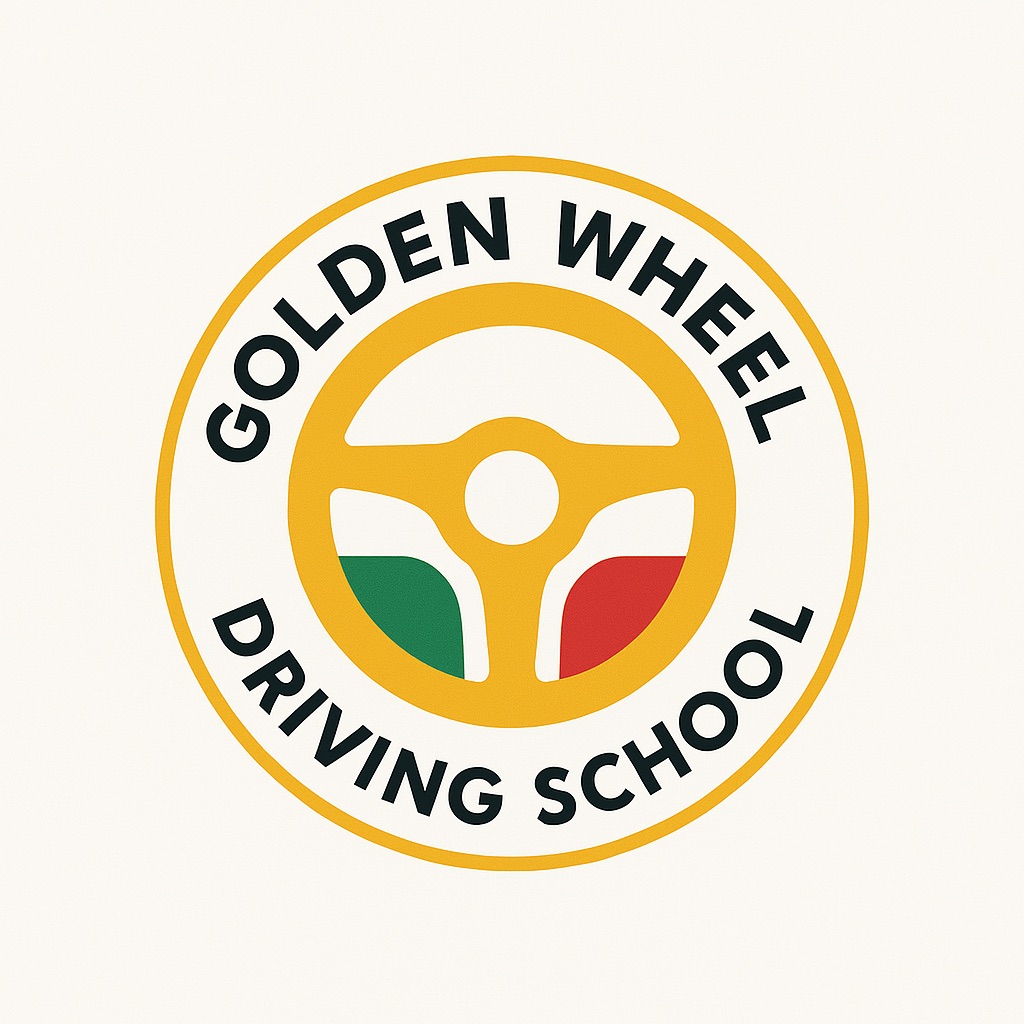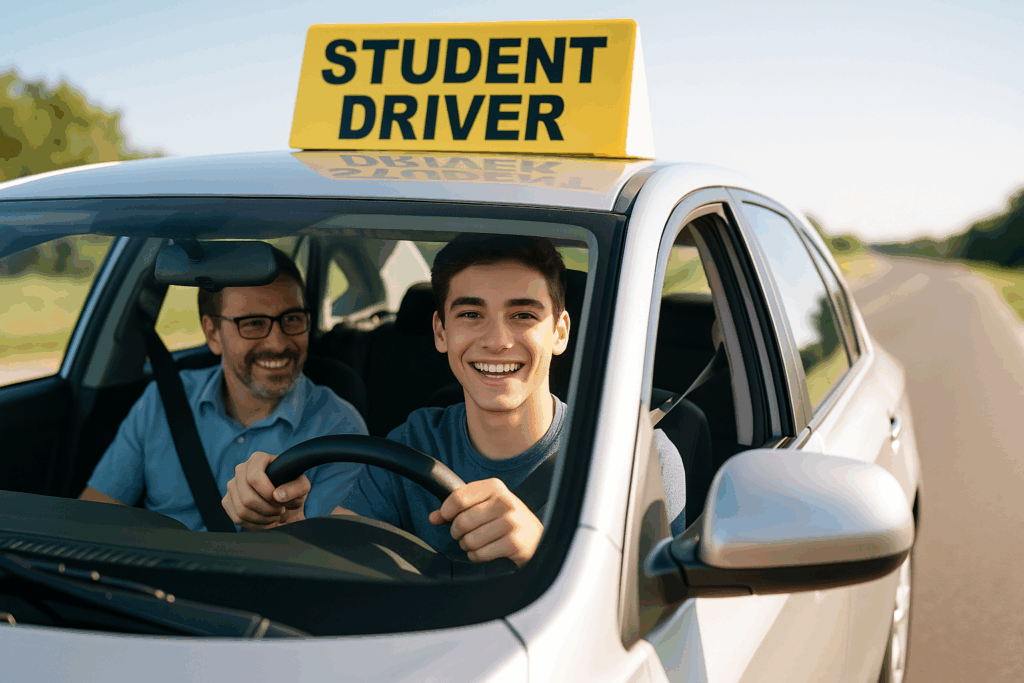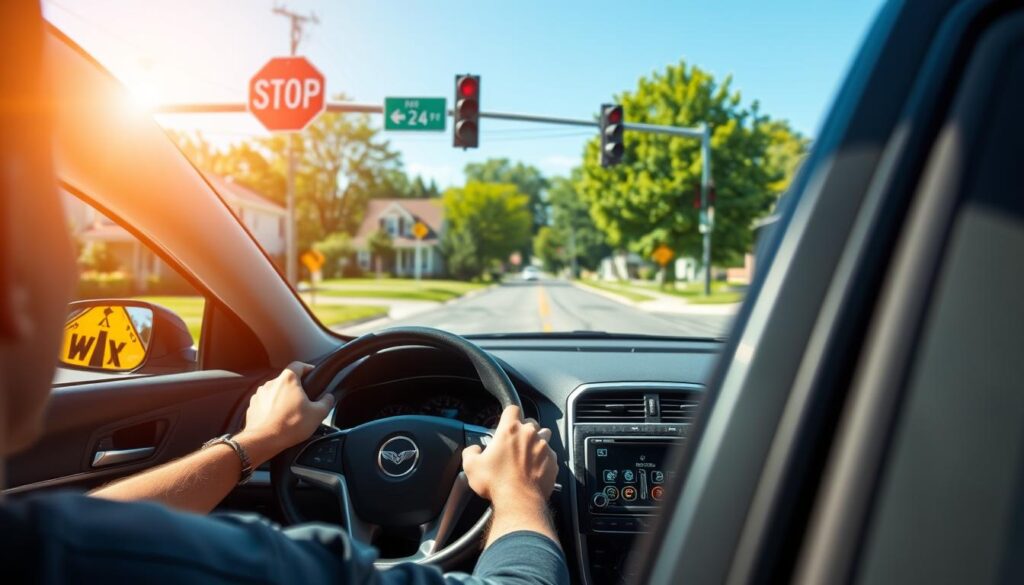Embarking on the journey to obtain your driver’s license is an exciting and significant milestone. Not only does it grant you independence, but it also opens up new opportunities for travel, work, and socializing. Driving lessons are an essential part of this process, providing you with the skills and confidence needed to navigate the roads safely.

Our comprehensive guide is designed to walk you through every step of learning to drive. From understanding the basics of driving to mastering complex maneuvers, we’ll cover it all. With patience, practice, and the right guidance, you’ll be well on your way to becoming a proficient driver.
Key Takeaways
- Understand the importance of driving lessons for new drivers
- Discover the structure of our comprehensive driving guide
- Learn how to prepare for your driving journey
- Find out what to expect from driving lessons
- Gain insights into becoming a confident driver
Getting Started on Your Journey to Learn to Drive
To get started on your driving journey, it’s essential to comprehend the legal requirements and associated costs in the US. Learning to drive is a significant milestone that requires careful planning and understanding of the processes involved.
Understanding the Legal Requirements in the US
The legal requirements for obtaining a driver’s license in the US vary by state, making it crucial to familiarize yourself with the specific regulations in your area. State-specific licensing procedures are designed to ensure that new drivers are adequately prepared for the responsibilities of driving.
State-Specific Licensing Procedures
Each state has its own licensing procedure, which includes different stages such as learner’s permits, provisional licenses, and full licenses. Understanding these stages is vital for a smooth licensing process.
Required Documentation for Permits
To apply for a learner’s permit, you will need to provide specific documents, including proof of identity, residency, and citizenship. Ensuring you have the necessary documentation will streamline the application process.
Age Restrictions and Permit Requirements
Age restrictions for obtaining a learner’s permit and subsequently a driver’s license vary by state. It’s essential to check the minimum age requirements and the duration for which you must hold a permit before being eligible for a license.
Costs Associated with Learning to Drive
Learning to drive comes with various expenses, including driving school fees, equipment, and testing fees. Understanding these costs will help you budget effectively for your driver’s education.
Budgeting for Lessons and Testing Fees
To get your license, you’ll need to budget for driving lessons and testing fees. Planning your expenses in advance will make the process less stressful and more manageable.
Choosing the Right Learning Method
When it comes to learning how to drive, the method you choose can significantly impact your experience.
Professional Driving Schools vs. Private Instruction
Deciding between enrolling in a professional driving school and receiving private instruction depends on your learning style and preferences.
Professional driving schools offer structured driving programs that cover both theoretical and practical aspects of driving.
Benefits of Structured Driving Programs
Structured driving programs provide a comprehensive curriculum that ensures you cover all necessary driving skills.
- Comprehensive coverage of driving rules and practices
- Experienced instructors who can provide feedback
- Practice tests to assess readiness for the driver’s license test
Finding a Qualified Driving Instructor
Finding a qualified driving instructor is crucial for effective learning.
Look for instructors who are certified, have good reviews, and offer flexible scheduling.
Online Resources and Driving Apps
In addition to traditional learning methods, online resources and driving apps can supplement your driving lessons.
Supplementary Learning Tools
Driving apps can provide practice tests, instructional videos, and tracking features to help you stay on top of your learning progress.
| Learning Method | Benefits | Considerations |
|---|---|---|
| Professional Driving Schools | Structured curriculum, experienced instructors | Cost, scheduling |
| Private Instruction | Personalized learning, flexible scheduling | Cost, quality of instruction |
| Online Resources and Apps | Supplementary learning, flexible access | Quality of content, limited feedback |
Understanding Vehicle Basics Before You Drive
Before you start driving, it’s crucial to understand the basics of vehicle operation to ensure a safe and enjoyable driving experience. Learning to drive involves more than just operating the vehicle; it requires a comprehensive understanding of how your vehicle works.
Essential Car Controls and Their Functions
Every vehicle has a set of essential controls that you need to be familiar with. These include the steering wheel, accelerator, brakes, and gearshift. Understanding the function of each control is vital for safe driving.
Manual vs. Automatic Transmission Differences
The type of transmission in your vehicle significantly affects how you drive. Manual transmissions require the driver to manually shift gears using the clutch and gearshift, while automatic transmissions automatically change gears based on speed and other factors. Understanding the differences between these two types can help you choose the right vehicle for your needs and driving style.
Dashboard Indicators and Warning Lights
Dashboard indicators and warning lights are critical for monitoring your vehicle’s status. Familiarize yourself with common indicators such as the oil pressure light, temperature gauge, and battery light. Knowing what these indicators mean can help you identify potential issues before they become major problems, ensuring your safety on the road.
Basic Vehicle Maintenance Knowledge
Basic vehicle maintenance is essential for keeping your vehicle in good condition. This includes checking tire pressure, oil levels, and brake pads. Regular maintenance not only enhances safety but also improves your vehicle’s performance and longevity.
Safety Checks Before Driving
Before driving, it’s essential to perform a few simple safety checks. These include checking that your lights are functioning, ensuring your tires are properly inflated, and verifying that your brakes are working correctly. By doing so, you can significantly reduce the risk of accidents and ensure a safe driving experience.
Mastering the Fundamental Driving Skills
To become a confident driver, it’s essential to grasp the basic driving skills that form the foundation of safe driving practices. Mastering these skills requires practice, patience, and a thorough understanding of the rules of the road.
Proper Seating Position and Mirror Adjustment
Before you start driving, ensure you’re comfortable and have a clear view of the road. Adjust your seat to a position where you can comfortably reach the pedals and steering wheel. Proper mirror adjustment is also crucial; align your rearview and side mirrors to minimize blind spots.
Starting, Stopping, and Steering Techniques
Learning smooth starting and stopping techniques is vital for safe driving. Practice starting from a standstill, accelerating smoothly, and braking gradually. Steering techniques, including hand positioning and turning, should also be practiced to improve your control over the vehicle.
Smooth Braking and Acceleration
Smooth braking and acceleration are key to defensive driving. Avoid sudden movements, as they can lead to loss of control or accidents. A driving instructor can provide personalized feedback on your braking and acceleration techniques.
Understanding Traffic Signs and Signals
Familiarizing yourself with traffic signs and signals is critical to knowing how to drive safely. Understand the meanings of different signs, signals, and road markings to navigate roads confidently.
Right-of-Way Rules in Different Scenarios
Understanding right-of-way rules is essential for safe driving. Know who has the right of way at intersections, roundabouts, and merging lanes to avoid conflicts with other drivers. Practice applying these rules in different scenarios to become a more confident driver.
By mastering these fundamental driving skills, you’ll be well-prepared to handle various driving situations and reduce your risk of being involved in an accident.
Advanced Techniques to Learn to Drive Safely
As you become more comfortable behind the wheel, it’s essential to learn advanced driving techniques to enhance your safety on the road. Advanced driving skills are not just about following the rules of the road; they’re about being proactive and anticipating potential hazards.
Defensive Driving Principles
Defensive driving is a set of skills and strategies that help you stay safe on the road by anticipating the actions of other drivers. It’s about being aware of your surroundings and taking steps to avoid potential dangers.
Anticipating Other Drivers’ Actions
A key aspect of defensive driving is anticipating what other drivers might do. This involves being vigilant and watching for signs that another driver might be about to make a mistake, such as drifting out of their lane or failing to signal.
Navigating Different Road Types
Different types of roads present unique challenges. Understanding how to navigate these roads safely is crucial for road safety.
Highway Driving Skills
Highway driving requires a different set of skills compared to driving in urban areas. It involves maintaining high speeds, navigating through heavy traffic, and being aware of large trucks and other vehicles.
Urban vs. Rural Driving Challenges
Urban driving is characterized by congested roads, pedestrians, and complex intersections, while rural driving often involves higher speeds and less visibility due to darkness or weather conditions. Each environment requires a tailored approach to defensive driving.
Driving in Challenging Weather Conditions
Weather conditions such as rain, snow, or fog can significantly impact driving safety. Learning how to adjust your driving to suit the weather is a vital driving lesson. This includes reducing speed, increasing following distances, and using appropriate vehicle settings like headlights or windshield wipers.
By mastering these advanced techniques, you’ll become a more confident and safe driver, capable of handling a variety of driving scenarios. Remember, the key to safe driving is a combination of knowledge, practice, and a proactive approach to anticipating and responding to hazards on the road.
Practicing Effectively to Build Confidence
Practicing driving is not just about logging hours; it’s about doing so effectively to build confidence. To learn to drive safely and competently, new drivers need to focus on structured practice that gradually increases in complexity.
Structured Practice Sessions for New Drivers
Structured practice involves creating a plan that covers various driving scenarios and conditions. This could include practicing in different weather conditions, on various road types, and during different times of the day. A driving instructor can be invaluable in helping to design such a practice plan.
Progressive Difficulty Approach
A progressive difficulty approach means starting with simple driving tasks and gradually moving to more complex ones. For example, beginning with driving in empty parking lots, then progressing to quiet neighborhood streets, and eventually moving on to busier roads.
Common Mistakes to Avoid While Learning
New drivers should be aware of common mistakes such as failing to check blind spots, not maintaining a safe following distance, and not being aware of their surroundings. Being mindful of these potential pitfalls can help learners get your license more quickly by avoiding bad habits.

Tracking Your Progress and Setting Goals
Tracking progress is crucial for staying motivated and identifying areas that need improvement. This can be done through regular feedback from a driving instructor or by maintaining a driving log.
Creating a Driving Log
A driving log allows learners to record their practice sessions, noting what they did well and what they struggled with. This can help in setting realistic goals for the next practice session and in monitoring overall progress.
By practicing effectively and being mindful of common mistakes, new drivers can build their confidence and become competent drivers more quickly.
Preparing for Your Driver’s License Test
To get your license, it’s essential to prepare well for the driver’s license test, which includes both a written test and a road test. The process can seem daunting, but with the right preparation, you can feel confident and ready for the challenge.
Written Test Preparation Strategies
The written test is the first hurdle to clear on your path to getting your driver’s license. It covers road signs, traffic laws, and safe driving practices.
Study Resources and Practice Tests
Utilize the driver’s manual provided by your state’s Department of Motor Vehicles (DMV) as your primary study resource. Practice tests are also invaluable; they help you assess your knowledge and identify areas that need more study.
- DMV’s official website for study materials and practice tests
- Mobile apps designed for driver’s test preparation
- Online forums and driving schools that offer study guides
Road Test Requirements and Expectations
The road test evaluates your ability to safely operate a vehicle. Understanding what to expect can significantly reduce your test-day anxiety.
Common Test Routes and Maneuvers
Familiarize yourself with common test routes and practice the required maneuvers, such as parallel parking, three-point turns, and merging onto busy roads.
| Maneuver | Description | Tips for Success |
|---|---|---|
| Parallel Parking | Parking your vehicle parallel to the road | Use reference points on your vehicle to gauge distance |
| Three-Point Turn | Reversing direction in a confined space | Check your mirrors and blind spots before starting |
| Merging | Joining a busy road safely | Match your speed to the traffic you’re merging into |
Day-of-Test Tips for Success
On the day of your test, arrive early and be prepared. Stay calm and focused, and follow the examiner’s instructions carefully.
Managing Test Anxiety
Test anxiety is common, but there are strategies to manage it. Deep breathing exercises and positive self-talk can help calm your nerves.
After Getting Your License: Continuing Education
Getting your driver’s license is an exciting achievement, and continuing education can enhance your driving skills. As a new driver, it’s essential to understand that having a license is not the end of your learning journey but rather a stepping stone to becoming a more confident and safe driver.
Graduated Licensing Systems in the US
The United States implements a Graduated Licensing System, which is designed to phase in driving privileges for new drivers. This system typically includes multiple stages, starting with a learner’s permit, followed by a provisional license, and finally, a full license.
Restrictions for New Drivers
During the provisional stage, new drivers often face certain restrictions, such as curfews, limits on the number of passengers, and prohibitions on driving under the influence. These restrictions aim to reduce the risk of accidents among new drivers.
Insurance Considerations for New Drivers
Insurance rates for new drivers can be higher due to the increased risk associated with inexperience. However, completing driver’s education courses can lead to insurance discounts.
Discounts for Driver Education
Many insurance companies offer discounts to drivers who have completed accredited driving courses. These discounts can significantly reduce insurance premiums, making it financially beneficial to continue driving education.
Advanced Driving Courses and Benefits
Advanced driving courses can provide new drivers with additional skills and knowledge, enhancing their safety on the road. These courses often cover defensive driving techniques, night driving, and driving in adverse weather conditions.
Specialized Skills Training Options
Some driving schools offer specialized courses, such as defensive driving, skid control, and eco-driving. These courses can help drivers develop specific skills that improve their overall driving competence.
Continuing education after getting your driver’s license not only enhances your driving skills but also contributes to road safety. By understanding graduated licensing systems, insurance considerations, and advanced driving courses, new drivers can become more confident and responsible drivers.
| Course Type | Description | Benefits |
|---|---|---|
| Defensive Driving | Techniques to anticipate and avoid hazards | Reduced risk of accidents, lower insurance rates |
| Skid Control | Training to regain control of a vehicle during a skid | Improved vehicle handling, enhanced safety |
| Eco-Driving | Methods to reduce fuel consumption and emissions | Cost savings on fuel, reduced environmental impact |

Conclusion
Learning to drive is a significant milestone that opens up new opportunities and independence. As you’ve progressed through this comprehensive guide, you’ve gained a solid foundation in the skills and knowledge required to become a proficient driver.
Enrolling in a reputable driving school and practicing under the guidance of a qualified instructor can significantly enhance your driving abilities. By focusing on road safety and adhering to best practices, you’ll not only become a skilled driver but also contribute to making the roads safer for everyone.
As you continue on your driving journey, remember that practice is key to reinforcing your skills. Stay committed to ongoing learning, and consider advanced driving courses to further refine your abilities. With persistence and dedication, you’ll become a confident and responsible driver, ready to tackle the challenges of the road.








